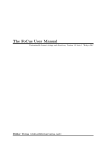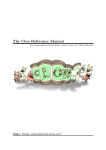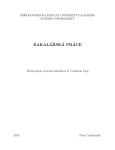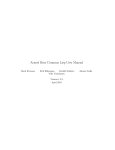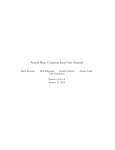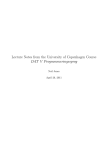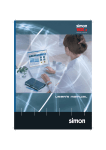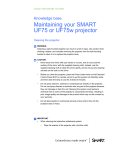Download The Declt User Manual
Transcript
The Declt User Manual Documentation extractor from Common Lisp to Texinfo, Version 2.0 "Kathryn Janeway" Didier Verna <[email protected]> c 2010–2013, 2015 Didier Verna Copyright Permission is granted to make and distribute verbatim copies of this manual provided the copyright notice and this permission notice are preserved on all copies. Permission is granted to copy and distribute modified versions of this manual under the conditions for verbatim copying, provided also that the section entitled “Copying” is included exactly as in the original. Permission is granted to copy and distribute translations of this manual into another language, under the above conditions for modified versions, except that this permission notice may be translated as well. i Table of Contents Copying . . . . . . . . . . . . . . . . . . . . . . . . . . . . . . . . . . . . . . . . . . . . . . . . . . . . . . . . . . . . 1 1 Introduction . . . . . . . . . . . . . . . . . . . . . . . . . . . . . . . . . . . . . . . . . . . . . . . . . . . 3 2 Installation . . . . . . . . . . . . . . . . . . . . . . . . . . . . . . . . . . . . . . . . . . . . . . . . . . . . . 5 3 Usage . . . . . . . . . . . . . . . . . . . . . . . . . . . . . . . . . . . . . . . . . . . . . . . . . . . . . . . . . . . 7 3.1 3.2 Customization . . . . . . . . . . . . . . . . . . . . . . . . . . . . . . . . . . . . . . . . . . . . . . . . . . . . . . . . . . . . . . . . . . . . . Coding Style . . . . . . . . . . . . . . . . . . . . . . . . . . . . . . . . . . . . . . . . . . . . . . . . . . . . . . . . . . . . . . . . . . . . . . 3.2.1 Taglines . . . . . . . . . . . . . . . . . . . . . . . . . . . . . . . . . . . . . . . . . . . . . . . . . . . . . . . . . . . . . . . . . . . . . . 3.2.2 Docstrings . . . . . . . . . . . . . . . . . . . . . . . . . . . . . . . . . . . . . . . . . . . . . . . . . . . . . . . . . . . . . . . . . . . . 3.2.3 80 Columns . . . . . . . . . . . . . . . . . . . . . . . . . . . . . . . . . . . . . . . . . . . . . . . . . . . . . . . . . . . . . . . . . . 3.3 Caveats . . . . . . . . . . . . . . . . . . . . . . . . . . . . . . . . . . . . . . . . . . . . . . . . . . . . . . . . . . . . . . . . . . . . . . . . . . . 3.3.1 SBCL Only . . . . . . . . . . . . . . . . . . . . . . . . . . . . . . . . . . . . . . . . . . . . . . . . . . . . . . . . . . . . . . . . . . . 3.3.2 Foreign Definitions . . . . . . . . . . . . . . . . . . . . . . . . . . . . . . . . . . . . . . . . . . . . . . . . . . . . . . . . . . . 3.3.3 Method Combinations . . . . . . . . . . . . . . . . . . . . . . . . . . . . . . . . . . . . . . . . . . . . . . . . . . . . . . . . 4 Advanced Usage . . . . . . . . . . . . . . . . . . . . . . . . . . . . . . . . . . . . . . . . . . . . . . 11 4.1 5 7 8 8 8 8 9 9 9 9 Version Numbering . . . . . . . . . . . . . . . . . . . . . . . . . . . . . . . . . . . . . . . . . . . . . . . . . . . . . . . . . . . . . . . 11 Conclusion . . . . . . . . . . . . . . . . . . . . . . . . . . . . . . . . . . . . . . . . . . . . . . . . . . . . 13 Appendix A A.1 A.2 Configuration . . . . . . . . . . . . . . . . . . . . . . . . . . . . . . . . . . . . . . . . . . . . . . . . . . . . . . . . . . . . . . . . . . . . 15 Supported Platforms . . . . . . . . . . . . . . . . . . . . . . . . . . . . . . . . . . . . . . . . . . . . . . . . . . . . . . . . . . . . . 15 Appendix B B.1 B.2 B.3 B.4 Technical Notes. . . . . . . . . . . . . . . . . . . . . . . . . . . . . . . . . . 15 Indexes . . . . . . . . . . . . . . . . . . . . . . . . . . . . . . . . . . . . . . . . . . . 17 Concepts . . . . . . . . . . . . . . . . . . . . . . . . . . . . . . . . . . . . . . . . . . . . . . . . . . . . . . . . . . . . . . . . . . . . . . . . Functions . . . . . . . . . . . . . . . . . . . . . . . . . . . . . . . . . . . . . . . . . . . . . . . . . . . . . . . . . . . . . . . . . . . . . . . . Variables . . . . . . . . . . . . . . . . . . . . . . . . . . . . . . . . . . . . . . . . . . . . . . . . . . . . . . . . . . . . . . . . . . . . . . . . Data Types . . . . . . . . . . . . . . . . . . . . . . . . . . . . . . . . . . . . . . . . . . . . . . . . . . . . . . . . . . . . . . . . . . . . . . 17 18 19 20 Copying Copying Permission to use, copy, modify, and distribute this software for any purpose with or without fee is hereby granted, provided that the above copyright notice and this permission notice appear in all copies. THIS SOFTWARE IS PROVIDED "AS IS" AND THE AUTHOR DISCLAIMS ALL WARRANTIES WITH REGARD TO THIS SOFTWARE INCLUDING ALL IMPLIED WARRANTIES OF MERCHANTABILITY AND FITNESS. IN NO EVENT SHALL THE AUTHOR BE LIABLE FOR ANY SPECIAL, DIRECT, INDIRECT, OR CONSEQUENTIAL DAMAGES OR ANY DAMAGES WHATSOEVER RESULTING FROM LOSS OF USE, DATA OR PROFITS, WHETHER IN AN ACTION OF CONTRACT, NEGLIGENCE OR OTHER TORTIOUS ACTION, ARISING OUT OF OR IN CONNECTION WITH THE USE OR PERFORMANCE OF THIS SOFTWARE. 1 Chapter 1: Introduction 3 1 Introduction Declt (pronounce “dec’let”) is a reference manual generator for Common Lisp libraries. It works by loading an ASDF system and introspecting its contents. The generated documentation contains the description of the system itself and its local dependencies (other systems in the same distribution): components (modules and files), packages and definitions found in those packages. Exported and internal definitions are listed separately. This allows the reader to have a quick view on the library’s public API. Within each section, definitions are sorted lexicographically. In addition to ASDF system components and packages, Declt documents the following definitions: constants, special variables, symbol macros, macros, setf expanders, compiler macros, functions (including setf ones), generic functions and methods (including setf ones), method combinations, conditions, structures, classes and types. The generated documentation includes every possible bit of information that introspecting can provide: documentation strings, lambda lists (including qualifiers and specializers where appropriate), slots (including type, allocation and initialization arguments), definition source file etc. Every documented item provides a full set of cross-references to related items: ASDF component dependencies, parents and children, classes direct methods, super and subclasses, slot readers and writers, setf expanders access and update functions etc. Finally, Declt produces exhaustive and multiple-entry indexes for every documented item. Reference manuals are generated in Texinfo format (compatible, but not requiring Texinfo 5). From there it is possible to produce readable / printable output in info, HTML, PDF, DVI and PostScript with tools such as makeinfo, texi2dvi or texi2pdf. The primary example of documentation generated by Declt is The Declt Reference Manual. Chapter 2: Installation 5 2 Installation Declt is currently an SBCL only library. It is provided as an ASDF 3 system. See Section A.2 [Supported Platforms], page 15, for more information. See Declt’s homepage for tarballs, Git repository and online documentation. Declt is also available via Quicklisp. In order to install and load the bare Lisp library, unpack it somewhere in the ASDF 3 source registry and type this at the REPL: (asdf:load-system :net.didierverna.declt) In addition to the bare Lisp library, the Declt distribution offers documentation in the form of 2 different manuals: the User Manual (you are reading it) and the Reference Manual. The latter is generated by Declt itself. If you want to benefit from all those wonders, some bits of manual installation are needed. After unpacking somewhere in the ASDF 3 source registry, please perform the following steps, in order. 1. Edit make/config.make to your specific needs. 2. Type make to compile the documentation (user manual and reference manual). By default, the documentation is built in info, PDF and HTML formats. If you want other formats (DVI and PostScript are available), type make all-formats. You can also type individually make dvi and/or make ps in order to get the corresponding format. 3. Type make install to install the documentation. If you have compiled the documentation in DVI and PostScript format, those will be installed as well. Type make uninstall to uninstall the library. Chapter 3: Usage 7 3 Usage Declt itself resides in a package called net.didierverna.declt. You can automatically nickname this package with the following function. nickname-package [NICKNAME] [Function] Add NICKNAME (:DECLT by default) to the :NET.DIDIERVERNA.DECLT package. Apart from that, Declt has a single entry point: the declt function. declt SYSTEM-NAME :KEY VALUE. . . [Function] Generate a reference manual in Texinfo format for ASDF SYSTEM-NAME. 3.1 Customization The Declt function accepts a number of keyword arguments allowing you to customize the generated reference manual. They are listed below. :library-name The library name, used in the reference manual title and at some other places. It defaults to the system name, but you are encouraged to provide a more humanreadable version, such as "Declt" instead of just net.didierverna.declt. :texi-file The full path of the generated Texinfo file. It defaults to LIBRARY-NAME.texi in the current directory. :info-file The base name of the info file, sans extension. The default is built from TEXI-FILE. :tagline A tagline for the library, use in the reference manual subtitle. It defaults to the system’s long name or description. :version The library’s version, used in the reference manual subtitle and at some other places. It defaults to the system’s version. :maintainer The library’s maintainer. It defaults to the system’s maintainer or author. Note that having a maintainer is mandatory to produce a reference manual (the maintainer appear on the title page). :contact The contact address for the library. The default is extracted from the system definition (either the maintainer, the author or the mailto slots). :license The library’s license type. This information is used to insert licensing information at several places in the manual. The default is nil and the possible values are: :mit, :bsd, :gpl and :lgpl. The corresponding license texts are stored in the *licenses* parameter. Please ask if you need other kinds of licenses added to Declt. Note that this information is not extracted from the system’s license slot, as this slot is not well defined. :copyright-date A copyright date to be used in conjunction with the licensing information. It defaults to the current year. You may use any kind of string here, such as "2013", "2010, 2011", "2010--2013" etc. :declt-notice Controls the output of a small paragraph about automatic manual generation by Declt. Possible values are nil, :short and :long (the default). I would be grateful 8 The Declt User Manual if you kept at least the short version in your manuals, as an acknowledgment for using Declt. :introduction A potential contents for an introductive chapter. :conclusion A potential contents for a conclusive chapter. :hyperlinks Whether to create hyperlinks to files or directories in the reference manual. Note that those links being specific to the machine on which the manual was generated, it is preferable to keep it to nil for creating reference manuals meant to be put online. Note that both the introduction and the conclusion may contain Texinfo directives (no postprocessing will occur). All other textual material is considered raw text and will be properly escaped for Texinfo. 3.2 Coding Style Some elements of your own coding style will affect the reference manuals generated by Declt. This section provides some recommendations that will make the generated output look nicer. 3.2.1 Taglines Unless you provide it with an explicit :tagline argument, declt uses the system’s long name or description to construct a subtitle. Consequently, it is advisable to use a single (short) line of text for these slots. The system’s long name should typically be the expansion of the system’s name, if that’s an acronym, or be left to nil. 3.2.2 Docstrings Declt tries to make the generated output look nicer in various ways. For example, setf functions are documented right after the corresponding reader (if any) instead of being listed under the “S” letter. In a similar vein, methods are documented as elements of their respective generic function, not as toplevel definitions. One thing that you can influence is Declt’s attempt at concatenating definitions. Concatenating may occur when there are definitions for both symbol and (setf symbol). This happens for accessor functions, generic functions or setf expanders. This also happens for accessor methods. If possible, Declt will try to generate a single definition for both the reader and the writer. That is only possible, however, if both definitions would render the same documentation, i.e. same package, source file and docstring. If you don’t provide a docstring, concatenation will work. If you provide different docstrings (like “Set the value of . . . ” and “Get the value of . . . ”), you will effectively prevent concatenation from happening. One thing I like to do is to provide the same neutral docstring for readers and writers. For instance “Access the value of . . . ”. This way, definitions can both provide a docstring and be concatenated together. 3.2.3 80 Columns All text coming from either Common Lisp or one of declt’s initialization arguments (:introduction and :conclusion excepted) is properly escaped for the Texinfo format, so you don’t need to worry about that. Declt also attempts to do some DWIM processing on things like docstrings, system long description etc.. In particular, it will try to detect paragraphs and short lines that should probably stand on their own. In order to do that, it assumes that your plain text is formatted to fit 80 columns. Chapter 3: Usage 9 3.3 Caveats Declt currently has two main limitations that you need to understand in order to avoid bad surprises. 3.3.1 SBCL Only First, Declt is an SBCL-only library. That is because it relies on sb-introspect. This limitation may be lifted in the future by using equivalent API from other Common Lisp implementations, but in the meantime, this means two things. 1. Declt can only document libraries that work with SBCL, because it needs to load them (see Chapter 1 [Introduction], page 3). 2. If your ASDF system contains vendor-specific modules or components, Declt will only be able to document SBCL-specific ones. Note that more generally, Declt only documents modules or components that ASDF actually loads, so if your system definition contains some form of conditional inclusion, this will affect the generated documentation. 3.3.2 Foreign Definitions In order to understand what a foreign definition is, you need to understand how Declt works first. This was briefly explained in the introduction, but here is the story again: Declt first loads the ASDF system from which it retrieves modules and components, notably including Lisp files. It then scans those Lisp files (including the system file itself), looking for package definitions (toplevel calls to DEFPACKAGE forms). Finally, it collects all definitions for the symbols in those packages. That is the extent of what is documented by Declt. In this context, a foreign definition is a definition that Declt would miss because of the way it works. This includes definitions found in one of the system’s files, but belonging to a package that was not defined in the system, packages defined by non-toplevel forms etc. Declt currently does not document foreign definitions, although in some cases, it is already possible to avoid missing them. In fact, the very question of deciding on whether foreign definitions should actually be documented is still open for discussion. See the TODO file in the distribution for more information. 3.3.3 Method Combinations The method combination interface in Common Lisp is a bit weird. In particular, although you define method combinations globally, changing them afterwards won’t affect already created generic functions. As a result, you could in theory end up with many different method combinations with the same name, used in various generic functions. See this blog entry (http: / / www . didierverna . net / blog / index . php ? post / 2013 / 08 / 16 / Lisp-Corner-Cases%3A-Method-Combinations) for more explanations. Declt assumes however that you have some sanity and only define method combinations once per name. They are documented as top level items and generic functions using them provide cross-references. Chapter 4: Advanced Usage 11 4 Advanced Usage This section contains information about different features that are present in Declt because of design decisions, but that I expect to be used only rarely, if at all. 4.1 Version Numbering As Declt evolves over time, you might one day feel the need for conditionalizing your code on the version of the library. The first thing you can do to access the current version number of Declt is use the version function. version &optional (TYPE :number) [Function] Return the current version number of Declt. TYPE can be one of :number, :short or :long. For :number, the returned value is a fixnum. Otherwise, it is a string. A Declt version is characterized by 4 elements as described below. • A major version number stored in the parameter *release-major-level*. • A minor version number, stored in the parameter *release-minor-level*. • A release status stored in the parameter *release-status*. The status of a release can be :alpha, :beta, :rc (standing for “release candidate”) or :patchlevel. These are in effect 4 levels of expected stability. • A status-specific version number stored in the parameter *release-status-level*. Status levels start at 1 (alpha 1, beta 1 and release candidate 1) except for stable versions, in which case patch levels start at 0 (e.g. 2.4.0). In addition to that, each version of Declt (in the sense major.minor, regardless of the status) has a name, stored in the parameter *release-name*. The general theme for Declt is “Star Trek Characters”. Here is how the version function computes its value. • A version :number is computed as major . 10000 + minor . 100 + patchlevel, effectively leaving two digits for each level. Note that alpha, beta and release candidate status are ignored in version numbers (this is as if the corresponding status level was considered to be always 0). Only stable releases have their level taken into account. • A :short version will appear like this for unstable releases: 1.3a4, 2.5b8 or 4.2rc1. Remember that alpha, beta or release candidate levels start at 1. Patchlevels for stable releases start at 0 but 0 is ignored in the output. So for instance, version 4.3.2 will appear as-is, while version 1.3.0 will appear as just 1.3. • A :long version is expanded from the short one, and includes the release name. For instance, 1.3 alpha 4 "Uhura", 2.5 beta 8 "Scotty", 4.2 release candidate 1 "Spock" or 4.3.2 "Counsellor Troy". As for the short version, a patchlevel of 0 is ignored in the output: 1.3 "Uhura". Chapter 5: Conclusion 13 5 Conclusion So that’s it I guess. You know all about Declt now. The next step is to polish your own libraries so that Declt can extract meaningful documentation from them. Then, you will want to run Declt on all the other libraries you use, in order to finally know how they work. Now, go my friend. Go document the whole Lisp world! Appendix A: Technical Notes 15 Appendix A Technical Notes This chapter contains important information about the library’s configuration and portability concerns. A.1 Configuration Some aspects of Declt’s behavior can be configured before the library system is actually loaded. Declt stores its user-level configuration (along with some other setup parameters) in another ASDF system called ‘net.didierverna.declt.setup’ (and the eponym package). In order to configure the library (I repeat, prior to loading it), you will typically do something like this: (require "asdf") (asdf:load-system :net.didierverna.declt.setup) (net.didierverna.declt.setup:configure <option> <value>) configure KEY VALUE [Function] Set KEY to VALUE in the current Declt configuration. Out of curiosity, you can also inquire the current configuration for specific options with the following function. configuration KEY [Function] Return KEY’s value in the current Declt configuration. Currently, the following options are provided. :swank-eval-in-emacs This option is only useful if you use Slime, and mostly if you plan on hacking Declt itself. The library provides indentation information for some of its functions directly embedded in the code. This information can be automatically transmitted to (X)Emacs when the ASDF system is loaded if you set this option to t. However, note that for this to work, the Slime variable slime-enable-evaluatein-emacs must also be set to t in your (X)Emacs session. If you’re interested to know how this process works, I have described it in the following blog entry: http: / / www . didierverna . net / blog / index . php ? post / 2011 / 07 / 20 / One-more-indentation-hack. A.2 Supported Platforms Declt is an ASDF 3 library. It currently works on Unix (including MacOS X) and Windows (Cygwin or MinGW) with SBCL only. Other Lisp implementations are not currently supported, as Declt relies on SBCL’s sb-introspect contrib. Appendix B: Indexes 17 Appendix B Indexes B.1 Concepts : F :swank-eval-in-emacs . . . . . . . . . . . . . . . . . . . . . . . . . . . 15 Foreign Definition . . . . . . . . . . . . . . . . . . . . . . . . . . . . . . . . . 9 C M Configuration . . . . . . . . . . . . . . . . . . . . . . . . . . . . . . . . . . . . 15 Configuration Option, :swank-eval-in-emacs . . . . 15 Method Combinations . . . . . . . . . . . . . . . . . . . . . . . . . . . . . 9 P Package, nicknames . . . . . . . . . . . . . . . . . . . . . . . . . . . . . . . 7 18 The Declt User Manual B.2 Functions C configuration . . . . . . . . . . . . . . . . . . . . . . . . . . . . . . . . . . . 15 configure . . . . . . . . . . . . . . . . . . . . . . . . . . . . . . . . . . . . . . . 15 D declt . . . . . . . . . . . . . . . . . . . . . . . . . . . . . . . . . . . . . . . . . . 7, declt, key, conclusion . . . . . . . . . . . . . . . . . . . . . . . . . . . . declt, key, contact . . . . . . . . . . . . . . . . . . . . . . . . . . . . . . . declt, key, copyright-date . . . . . . . . . . . . . . . . . . . . . . . declt, key, declt-notice . . . . . . . . . . . . . . . . . . . . . . . . . declt, key, hyperlinks . . . . . . . . . . . . . . . . . . . . . . . . . . . . declt, key, info-file . . . . . . . . . . . . . . . . . . . . . . . . . . . . . declt, key, introduction . . . . . . . . . . . . . . . . . . . . . . . . . 8 8 7 7 7 8 7 8 declt, declt, declt, declt, declt, declt, key, key, key, key, key, key, library-name . . . . . . . . . . . . . . . . . . . . . . . . . license . . . . . . . . . . . . . . . . . . . . . . . . . . . . . . . maintainer . . . . . . . . . . . . . . . . . . . . . . . . . . . . tagline. . . . . . . . . . . . . . . . . . . . . . . . . . . . . 7, texi-file . . . . . . . . . . . . . . . . . . . . . . . . . . . . . version . . . . . . . . . . . . . . . . . . . . . . . . . . . . . . . 7 7 7 8 7 7 N nickname-package . . . . . . . . . . . . . . . . . . . . . . . . . . . . . . . . 7 V version. . . . . . . . . . . . . . . . . . . . . . . . . . . . . . . . . . . . . . . . . . 11 Appendix B: Indexes 19 B.3 Variables * P *licenses* . . . . . . . . . . . . . . . . . . . . . . . . . . . . . . . . . . . . . . . 7 *release-major-level* . . . . . . . . . . . . . . . . . . . . . . . . . 11 *release-minor-level* . . . . . . . . . . . . . . . . . . . . . . . . . 11 *release-name* . . . . . . . . . . . . . . . . . . . . . . . . . . . . . . . . . 11 *release-status* . . . . . . . . . . . . . . . . . . . . . . . . . . . . . . . 11 *release-status-level* . . . . . . . . . . . . . . . . . . . . . . . . 11 Parameter, Parameter, Parameter, Parameter, Parameter, Parameter, N net.didierverna.declt.configuration . . . . . . . . . 15 *licenses* . . . . . . . . . . . . . . . . . . . . . . . . . . . . 7 *release-major-level* . . . . . . . . . . . . . . 11 *release-minor-level* . . . . . . . . . . . . . . 11 *release-name* . . . . . . . . . . . . . . . . . . . . . . 11 *release-status* . . . . . . . . . . . . . . . . . . . . 11 *release-status-level* . . . . . . . . . . . . . 11 S slime-enable-evaluate-in-emacs . . . . . . . . . . . . . . . 15 20 The Declt User Manual B.4 Data Types N net.didierverna.declt . . . . . . . . . . . . . . . . . . . . . . . . 5, 7 net.didierverna.declt.setup. . . . . . . . . . . . . . . . . . . 15 P Package, net.didierverna.declt . . . . . . . . . . . . . . . . . 7 Package, net.didierverna.declt.setup . . . . . . . . . 15 S sb-introspect . . . . . . . . . . . . . . . . . . . . . . . . . . . . . . . . 9, 15 System, net.didierverna.declt . . . . . . . . . . . . . . . . . . 5 System, net.didierverna.declt.setup . . . . . . . . . . 15 System, sb-introspect . . . . . . . . . . . . . . . . . . . . . . . . 9, 15
























